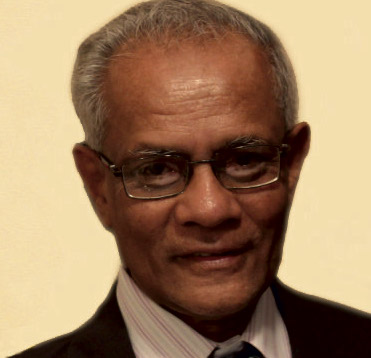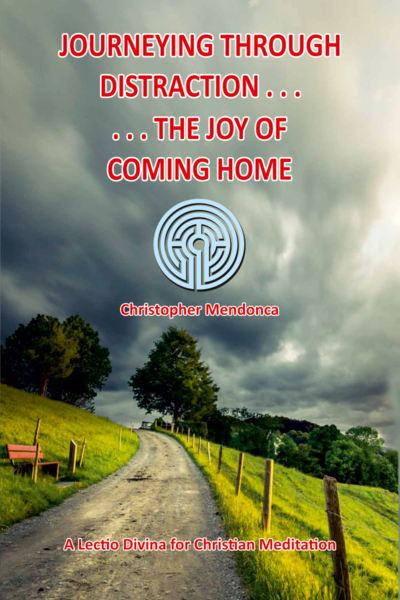We’ve interviewed author Christopher Mendonca, meditator from India on his recent book titled: ‘Journeying through Distraction . . . . . . the Joy of Coming Home – A Lectio Divina for Christian Meditation‘
If you’re interested in purchasing the book, you can find it on WCCM Media Store

Can you tell us a little bit about the journey that led you to write this book?
The Chapters of the book represent various stops on my Spiritual Journey.
They are a collection of Reflections, written for the Seasons of Advent and Lent of the Liturgical Year regularly published in the columns of The Examiner, our Bombay Archdiocesan Catholic News Weekly with a wide readership in India. The earliest of these was in 1971. Since they were much appreciated by both priests and lay faithful, I published these collected works in 1993 in a book entitled “Listening from Within”.
They resonated with the Liturgical texts of the Sundays of Advent and Lent, Christmas, Holy Week and the Sacred Triduum. As I read them now, I can see that the core content of that book has within it the “Seeds of Contemplation” that make up the present book.
By 1995 however, without my knowing it, I had begun a journey of descent from the head to the heart. I continued to write each year; each reflection was discrete and apparently unconnected. In November 2000, Fr. Laurence Freeman visited Mumbai and introduced me to the practice of Meditation. The dawn had given way to daylight. Argument and Understanding that shaped my first book, made way for Mystery and Experience that unmistakably characterize the present publication. If the first, contained nothing except what I was ‘convinced’ of, the second contains nothing that is not the result of a ‘personal experience’, the outcome of ‘contemplating the Mystery in faith’. This is the common thread that runs through the whole book. As Fr. Laurence aptly says in his Foreword to the book, “it explores the living Word of familiar Scripture with a freshness, clarity and sense of wonder arising from a mature contemplative approach formed by the daily practice of meditation.”
The book, therefore, has not been written as a book, but rather presented as a diary of a journey albeit not arranged in chronological order but for convenience, following the order of the unfolding of the Covenant in the Old and New Testaments.
Each soliloquy and reflection in your book is prefaced with a quote...Can you tell us the role these quotes play in the book?
I thought it relevant to link the Scriptures to the Teaching of Meditation. By doing so, I hope it will provide a Scriptural basis for various aspects of the teaching. Part of the ascesis lies in uncovering the link between the two. In this way our understanding of both the daily practice as well as the Scriptures are deeply personal, enhanced and deepened. Hence the sub-title – A Lectio Divina for Christian Meditation. The teaching on the practice of meditation notably by John Main and Laurence Freeman is thus given flesh and blood by men and women who lived and experienced the Covenant as it unfolded in history.
It took me time to read the sixty reflections in this book. It took me more time to reflect on the rich treasures contained therein. It will take me a little more than a lifetime to absorb and assimilate, enter into, explore, enjoy and experience these treasures. I can honestly confess that when I had finished reading and reflecting on this spiritual classic by Christopher Mendonca, which I am both honoured and humbled to attempt to review, I felt like a worm in front of a dragon! And if you find the Welsh dragon too terrifying, I saw myself as a drop in the ocean only to be gently reminded that the ocean is in the drop. "
Msgr. Alex Rebello
Who would you recommend this book to?
Definitely to Meditators in the Christian Tradition as a companion to their daily practice. It may be profitably used as a companion during a personal silent retreat. Two of my priest friends intend to use it as a resource for the Spiritual formation of those preparing for Priestly Ordination. It will obviously have a limited readership since it will only appeal to those who have experienced the call to journey to their centre. It would most certainly find favour with those who undertake the practice of meditation not as a technique to achieve well-being, but those who accept it as a Spiritual Discipline. Many are not familiar with the Biblical roots of the practice. This book will hopefully be what they are looking for.
How do the Scriptures relate to the practice of meditation?
The Key themes of the teaching on Christian Meditation are congruent with the Key Themes of God’s Revelation to us through his presence in the Written Word and definitively through the Spoken Word of God made flesh in Jesus. The Lord deals with us personally just as he did with his Chosen People. The tradition of monologistic prayer, the faithful repetition of one’s Sacred Word, rediscovered by John Main and made available once again to the Western Christian Tradition particularly to the lay faithful has special relevance. God speaks and Creation begins to BE. The revelation of God’s Word through the Patriarchs and Prophets is deepened in a progressive manner, encountering the ‘distractions’ of his people who frequently wander away and need to return to him. The ‘distraction’ that sin can only be remedied by a ‘metanoia’ a turnaround, a return to the centre. This is the leitmotif of the tapestry woven into the Old Testament. It reaches its fulfilment with the final and definitive revelation of the WORD made flesh, who comes to dwell with us and within us. The Opening Prayer for Meditation by John Main says is all: Heavenly Father, open our hearts to the Silent presence of the Spirit of your Son. Lead us into that mysterious silence where your WORD is revealed to all who call, Ma-ra-na-tha! Come, Lord Jesus!




